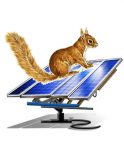 Spring may be here officially, but tell that to the squirrels here in New England. They are still risking suffocation by snow as they scramble from tree trunk to tree trunk. Given the options, hanging out in a cozy nest under a canopy of solar panels sounds pretty good.
Spring may be here officially, but tell that to the squirrels here in New England. They are still risking suffocation by snow as they scramble from tree trunk to tree trunk. Given the options, hanging out in a cozy nest under a canopy of solar panels sounds pretty good.
Unfortunately, squirrels and solar don’t mix well for home and business owners expecting years of maintenance-free, safe operations of their systems.
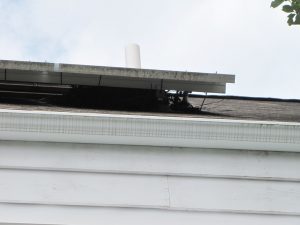
Squirrel nest at the bottom right corner of the panel
The good news is, squirrel damage to solar energy systems is rare. In 9 years, due in part to our installation methods, we’ve only had three squirrel nests. The bad news is, when squirrel damage happens, it’s a potential safety issue and a real expense for the owners.
One of the reasons we install panels about 6” off the roof is to deter rodents from building nests under the panels. This usually works because apparently 6” of headroom is too much for a cozy nest, and because it limits the amount of debris that can get trapped under the panels and provide a “starter home” for the rodents. Unfortunately installers from other warmer and less treed parts of the country don’t appreciate our approach, but then, they don’t have our variety of leaves, twigs, evergreen needles, and rodents to contend with. A common example of the “California Import” are aprons mounted on the front row of panels. While they give the installations a nice, neat appearance, they are an ideal debris trap and nest invitation.
However, even with safeguards, the occasional industrious squirrel sets up camp, usually enticed by a nearby bird-feeder, or a dangling tree branch that facilitates roof explorations. The worst case we’ve seen was late last year when a routine inspection of an existing system in preparation for system expansion uncovered a nest and substantial damage to the wires under the panels. As these photos show, the squirrels chewed right through the protective insulation to the bare wire and exposed live wires to the elements.
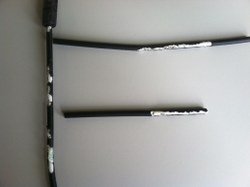
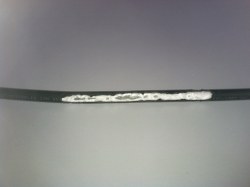
The best way to avoid squirrel problems is to keep them off your roof. You can do this by making it harder for them to get on, or less interesting. For example, keep your bird feeders far away from your house and trim back close or overhanging branches.
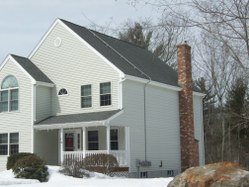
And if you have solar installed by a company other than New England Clean Energy, please don’t let them run conduit down an entire roof like on this home (at left). We spotted this install in Central Massachusetts. Not only is the conduit unsightly, it’s basically a squirrel ladder.
If you liked this article, you might also enjoy:
- Tree Math 2: Solar vs. Trees, What’s the Carbon Trade-off?
- Solar Makes Sense, Even in Snowy Climates
- It’s Pollen Season – Do You Know What Your Panels are Doing?




